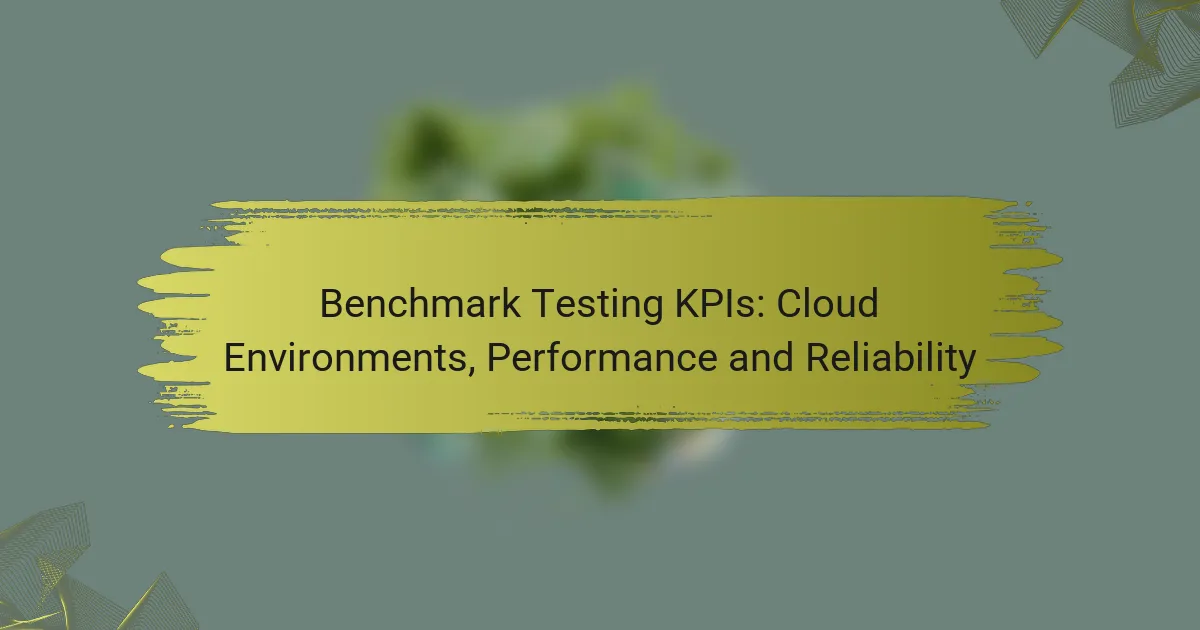Benchmark testing in cloud environments is essential for evaluating performance and reliability through specific key performance indicators (KPIs). Metrics such as response time, throughput, error rate, and resource utilization provide insights into how effectively cloud services meet user demands and operational standards. Additionally, reliability metrics like mean time to recovery (MTTR) and service level agreements (SLAs) are crucial for ensuring that cloud services maintain high availability and performance under varying conditions.

What are the best KPIs for benchmark testing in cloud environments?
The best KPIs for benchmark testing in cloud environments focus on measuring performance and reliability. Key indicators include response time, throughput, error rate, resource utilization, and availability, which help assess how well cloud services meet user demands.
Response time
Response time measures how quickly a cloud service responds to requests. Typically, low response times are crucial for user satisfaction, with acceptable ranges often falling between low tens of milliseconds to a few hundred milliseconds, depending on the application type.
To optimize response time, consider using content delivery networks (CDNs) to reduce latency and ensure that your cloud infrastructure is geographically distributed to serve users more efficiently.
Throughput
Throughput indicates the amount of data processed by a cloud service over a specific period, often measured in requests per second or transactions per minute. High throughput is essential for applications with heavy user traffic, such as e-commerce platforms or streaming services.
To enhance throughput, evaluate your cloud architecture and consider load balancing strategies to distribute traffic evenly across servers, thus preventing bottlenecks during peak usage times.
Error rate
Error rate tracks the frequency of failed requests or transactions in a cloud environment. A low error rate is critical for maintaining user trust and service reliability, with acceptable levels often below 1% for most applications.
Regularly monitor error rates and implement automated alerting systems to quickly identify and resolve issues, ensuring that your cloud services remain operational and efficient.
Resource utilization
Resource utilization measures how effectively cloud resources, such as CPU, memory, and storage, are being used. Efficient resource utilization helps optimize costs and performance, with ideal usage typically ranging between 60% to 80% for most resources.
To improve resource utilization, consider implementing auto-scaling features that adjust resources based on demand, ensuring that you only pay for what you need while maintaining performance levels.
Availability
Availability refers to the percentage of time a cloud service is operational and accessible to users. High availability is crucial for business continuity, with targets often set at 99.9% uptime or higher.
To achieve high availability, implement redundancy strategies, such as multi-region deployments and failover systems, to minimize downtime and ensure that services remain accessible even during outages or maintenance periods.

How to measure performance in cloud environments?
Measuring performance in cloud environments involves assessing various metrics that indicate how well applications run and respond under different conditions. Key performance indicators (KPIs) include response times, throughput, and resource utilization, which help identify areas for improvement and ensure reliability.
Using load testing tools
Load testing tools simulate multiple users accessing your application simultaneously to evaluate its performance under stress. These tools can help identify bottlenecks, such as slow database queries or insufficient server resources, before they impact real users.
Popular load testing tools include Apache JMeter, LoadRunner, and Gatling. When selecting a tool, consider factors like ease of use, integration capabilities, and support for cloud environments.
Monitoring APIs
Monitoring APIs is crucial for understanding how well your cloud applications perform and interact with other services. By tracking API response times, error rates, and request volumes, you can gain insights into the overall health of your application.
Utilize monitoring solutions like New Relic, Datadog, or AWS CloudWatch to automate the tracking of these metrics. Set up alerts for unusual patterns, such as spikes in error rates, to quickly address potential issues.
Analyzing user experience
Analyzing user experience involves gathering feedback and data on how users interact with your application. Key metrics include page load times, user engagement rates, and conversion rates, which can highlight areas needing enhancement.
Tools like Google Analytics and Hotjar can provide valuable insights into user behavior. Regularly review this data to make informed decisions about performance optimizations and ensure a smooth user experience.

What are the key reliability metrics for cloud services?
The key reliability metrics for cloud services include mean time to recovery (MTTR), service level agreements (SLAs), and incident response time. These metrics help organizations assess the performance and reliability of their cloud environments, ensuring they meet user expectations and business needs.
Mean time to recovery (MTTR)
Mean time to recovery (MTTR) measures the average time taken to restore a service after a failure. It is crucial for understanding how quickly a cloud service can recover from outages, impacting overall reliability. A lower MTTR indicates a more resilient service.
To calculate MTTR, sum the total downtime and divide it by the number of incidents. For example, if a service experiences three outages totaling 30 minutes, the MTTR would be 10 minutes. Organizations should aim for an MTTR in the low single-digit minutes for optimal performance.
Service level agreements (SLAs)
Service level agreements (SLAs) are formal contracts between service providers and customers that define the expected level of service, including uptime guarantees and performance benchmarks. SLAs are essential for setting clear expectations and accountability in cloud services.
Common SLA metrics include uptime percentages, typically ranging from 99.0% to 99.9%, and response times for support requests. When evaluating cloud providers, carefully review their SLAs to ensure they align with your business requirements and risk tolerance.
Incident response time
Incident response time refers to the duration it takes for a cloud service provider to acknowledge and begin addressing an incident after it has been reported. Quick incident response is critical for minimizing downtime and maintaining service reliability.
Effective incident response times can vary, but best practices suggest aiming for acknowledgment within minutes and resolution within hours for critical issues. Organizations should establish clear communication channels with their cloud providers to ensure timely updates during incidents.

How to select the right cloud service provider?
Selecting the right cloud service provider involves evaluating their performance, reliability, and support capabilities. Prioritize providers that align with your specific business needs and compliance requirements.
Evaluating performance benchmarks
Performance benchmarks are critical in assessing how well a cloud service provider can meet your operational demands. Look for metrics such as uptime percentages, response times, and throughput rates. A reliable provider typically offers uptime guarantees of 99.9% or higher.
Consider conducting load testing to simulate your application’s behavior under various conditions. This helps identify potential bottlenecks and ensures the provider can handle peak loads effectively.
Comparing SLAs
Service Level Agreements (SLAs) define the expected performance and reliability standards of a cloud provider. Compare SLAs based on uptime guarantees, response times for support, and penalties for non-compliance. A strong SLA should clearly outline the provider’s commitments and your recourse in case of service failures.
Pay attention to the specifics of the SLA, including how downtime is calculated and what constitutes an acceptable level of service. Look for providers that offer transparent terms and conditions to avoid surprises later.
Assessing customer support
Effective customer support is essential for resolving issues quickly and minimizing downtime. Evaluate the support channels offered, such as phone, email, and live chat, and their availability (24/7 support is often ideal). Check for user reviews to gauge the responsiveness and effectiveness of the support team.
Consider the provider’s knowledge base and community forums as additional resources. A well-documented support system can empower your team to troubleshoot minor issues independently, enhancing overall efficiency.

What tools are available for benchmark testing?
Benchmark testing in cloud environments can be effectively conducted using various tools designed to assess performance and reliability. These tools help simulate user load and measure system response, enabling organizations to identify bottlenecks and optimize resources.
Apache JMeter
Apache JMeter is an open-source tool widely used for performance testing of web applications. It allows users to create test plans that simulate multiple users accessing the application simultaneously, providing insights into response times and throughput.
When using JMeter, consider its ability to handle various protocols, including HTTP, FTP, and JDBC. It is particularly useful for testing applications in cloud environments due to its scalability and flexibility. However, users should be aware of its steep learning curve for advanced features.
LoadRunner
LoadRunner, developed by Micro Focus, is a comprehensive performance testing tool that supports a wide range of applications and protocols. It enables users to simulate thousands of users and analyze system behavior under load, making it ideal for enterprise-level testing.
One key advantage of LoadRunner is its robust analytics capabilities, which help identify performance issues quickly. However, it can be costly, and organizations should weigh the investment against their specific testing needs and budget constraints.
Gatling
Gatling is a powerful open-source load testing tool known for its high performance and ease of use. It is particularly suited for testing web applications and APIs, providing detailed reports on performance metrics.
Gatling’s scripting language is based on Scala, which may require some programming knowledge. Its real-time monitoring features and ability to simulate large-scale traffic make it a strong choice for teams looking to optimize cloud-based applications. Users should ensure they have the necessary skills to leverage its full potential effectively.



